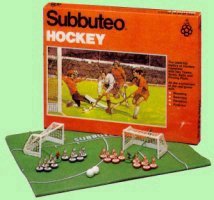
| Peter Upton's |
Subbuteo Tribute Website. |
There are currently three sports shown on this page, as the racing games now have their own page. There is also a Subbuteo Journey into Space game from the 1950s, which is in my Miscellaneous section. There may well be other sets, as Subbuteo still manages to surprise me. Unlike the rest of the site, this page isn't in date order. I guess I just wanted to put Hockey first because it was on my wish list for so long and I was chuffed when I finally obtained a set. However, hockey is also the one set here that really links up with the classic football game.
After Peter Adolph sold Subbuteo Sports Games to Waddingtons in the late 1960s, he continued to design tabletop sports games. He is credited with a game called Mini-Baseball, and pattern maker Andy Stadden (son of the great Charles Stadden), remembers working on an 80mm baseball figure and golfer for Peter Adolph in the early 1990s (Mr Adolph sadly passed away in 1994). Andy also remembers a cycling game being mentioned at this time.
Hockey.
Hockey was actually a perfect sport for Subbuteo to represent. Unlike rugby and cricket, this set had the simple fast-flowing Subbuteo we know and love. As you can see from the illustrations, the set was similar to a football club edition, but all the pieces had been specially designed. The balls were smaller than their football equivalent, and so were the goals. The goalkeeper's control rod had to go over the large board on the back of the goal. This feels awkward if you are used to the football version, as the end of the rod is now floating in the air, and is more unstable. The goalkeeper figures were well detailed, with masks, and little sticks which looked way too flimsy to survive very long with balls being blasted at them. The outfield players were a delight, being well designed and painted in an attractive colour scheme.




The hockey players were produced in both white and flesh plastic, and both types are now illustrated above (look at the colour of the peg at the player's feet). Whilst the heavyweight football figures were produced in both types of plastic, the zombies and lightweights were only produced in white. So it was a little odd that the hockey players were produced in both types. The kits on each type are identical, although obviously different parts have to be painted on each.
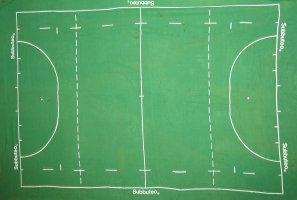

Spot the difference! "Baize" or "Nylon"
A second variation relates to the pitch. It was usually made from the horrible 1980s nylon material, but if you were lucky, you could get a 1970s style baize cloth. Having just photographed my "baize" pitch, it is worth noting that this has the more modern "Subbuteo" logos, whereas the "nylon" has "SUBBUTEO" in capitals..... The baize is the thinner material that started appearing at the end of the 1970s (my original football set of 1979 had this style), but it is still much better than the threaded "nylon" pitch, mostly because it lays flat on hard board or (as here) carpet.
It's a shame that hockey didn't get a bigger audience. If it had survived to the British successes at the Olympics (was it 1988?) perhaps we would've seen men's and women's teams in international team colours. Hmmm, Holland vs Pakistan - I can see it now...

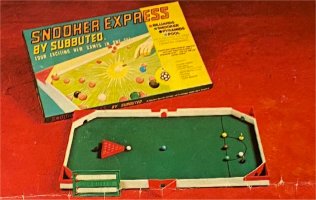

This was one of the big sets of the mid seventies, where the box was also the pitch with the sides making a fence surround (see also Football Express and Targetman). Snooker Express contains "player figures, 15 red balls, 6 colour balls, 2 white balls, 1 triangle, 6 pockets, scoreboard and rule book". The box states that billiards, snooker, pyramids and pool could be played. So it is basically snooker except you use a flicked player instead of a cue. The player did not stay on the pitch between flicks, and you placed him behind the cue ball before flicking.
This game always struck me as a bit pointless. You can't put a real football pitch in your bedroom, but if you have room for Snooker Express, then you have room for a mini snooker table. There's something satisfying about thwacking a ball with a cue...
What is obvious from looking at the above picture is that the playing area is not really like a snooker table, as the corner "pockets" are set inside the corners of the pitch, with a small entrance hole in the middle of the diagonal side. The two side pockets have to be outside of the pitch of course, so these are provided separately, and simply clip onto the walls of the box. The cushions are not just card like Football Express, but have foam padding glued to them, which gives a bit of bounce.
The main problem with this set was that it was just too hard to play. You could be knocking those balls around all night, and the winner would be the player with the least fouls. I wonder how much play testing was done on the pitch, as the real problem is the corner pockets. You cannot roll a ball along the cushion into the pocket as in snooker, and the holes are really, really small. Arrgggg.
The rules do offer a "beginners" method of play where you dispense with the playing figure, and just flick the cue ball with your finger. This gives much more control, but it is still too difficult to actually pot anything at all. Frankly, this was a complete disaster.


Despite my reservations about the point and playability of this set, there is no doubt that it was another attractive Subbuteo product, and the components were once again delightful. The little player polishing his cue, set within a rugby base is the best thing about the whole set, and immediately ties the game to the Subbuteo brand. The scoreboard with Subbuteo logo is also a great design, and very practical for adding up all those fouls....
Snooker Express - Italian Version.


Whilst snooker has always been a popular game in the UK, the Snooker World Championships in Sheffield each year show that the game is not so huge outside these shores, and there seems an absence of Continental players. This did not seem to stop Subbuteo from sending Snooker Express games to Italy, and I expect it sold even more poorly there than in the UK. To counter this, it seems as if an "Edizone Italiana" was produced, probably by Parodi. With the addition of a tiny bag of cheap looking additional pieces, the number of games expanded from four to fifteen. For the record, the other eleven Italian games were - buche, birilli, bazzica, boccette, carambola, parigina, parigina russa, boccetta russa, carolina, ometti di calcio o goriziana (phew), and bersagliera. Lets hope at least a couple of these did not require you to pot anything in those useless pockets.
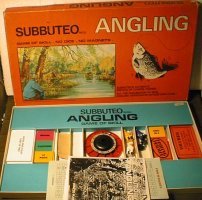

Once you have all your tackle, you can think about fishing. For this, you have to land on a water square, hand in a permit if needed, check what types of fish are available and whether you have the right type of bait to catch them, then turn over a card in the "Cast" pile. If you are very lucky, you will get a picture of a fish which matches the water you are fishing in, and the bait you are using. If so, roll on the dicer, and cross reference this to the fish weight "ready reckoner" to see what size fish you have caught.
This is actually a good fun board game. It is well though out, and the chances are that you'll be catching you fair share of 1oz Gudgeon, while your opponent flukes a 12lb Carp! The chances of getting a big fish are suitably small, and the later stages of the game are a chase to find the right bait. Although by this time you've probably collected a fair amount of different lines and hooks. And there's nothing more annoying than losing your hook and float in a tree, or finding those precious maggots have gone mouldy.


The playing pieces are well designed, with the fishermen being chunky and having separate rods provided (although in some ways it's a shame they are not OO scale). The fish cards are also nicely done, but the dicer is a bit disappointing. The ball-bearing simply drops onto a raised central area which slopes away to the numbered trays around the edge of the dicer. If you've used the rugby scrummer, then this uses the same principles. Occasionally, the ball-bearing gets stuck inside the dicer, and I'm not convinced it is as random as using dice would be. The Angling box states "a game of skill. no dice. no magnets" which is a bit of a fib, seeing as the dicer does exactly the same job as a twelve sided dice.
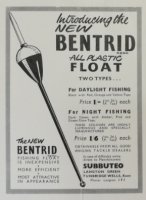
The Angling board game was not Subbuteo's first fishing related item. In the 1960s their plastic moulding arm (Subbuteo Ltd, rather than Subbuteo Sports Games Ltd), produced a range of plastic floats for real life anglers. Check out the Miscellaneous Items page for more details on this obscure little product.
The questions that may occur to you here is :- What sport would you have liked to see as a Subbuteo game? Are there any more sports that would be easy to recreate? Why are you still looking at this page? Who knows. Choose from the pages below if you want to investigate some of the more mainsteam Subbuteo stuff: